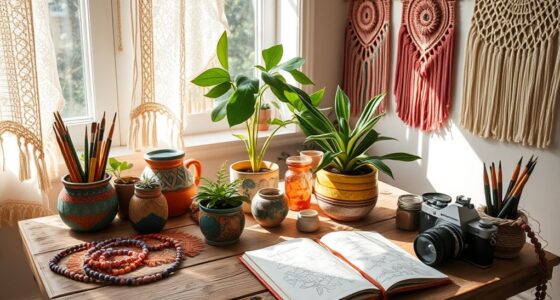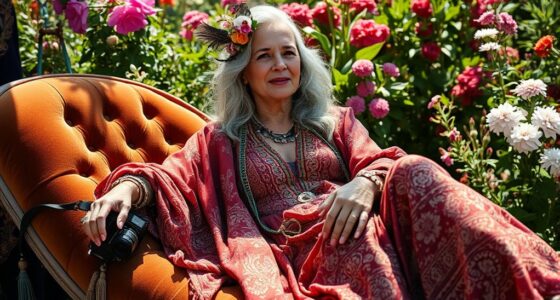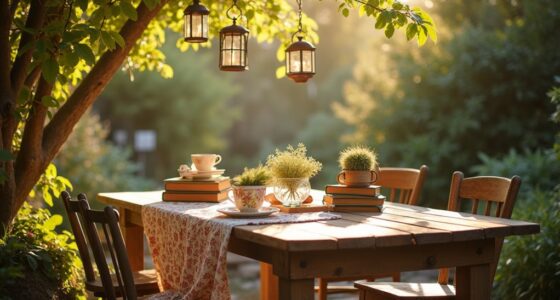The bohemian lifestyle started with the 1960s hippies, who embraced free expression, social activism, and colorful fashion rooted in cultural roots. Over time, this spirit evolved into urban street art, vintage styles, and eco-conscious choices associated with modern hipsters. Today, bohemia blends art, fashion, and individualism in new ways, focusing on authenticity and sustainability. If you explore further, you’ll discover how this timeless vibe continues to inspire creative living worldwide.
Key Takeaways
- The bohemian lifestyle evolved from 1960s hippie counterculture emphasizing peace, love, and social activism to modern hipster values of individualism and urban sophistication.
- Hippies popularized vibrant fashion, music, and communal living, which influenced contemporary bohemian aesthetics seen in vintage, artisanal, and eco-friendly trends.
- Over time, bohemia integrated sustainability and minimalism, shifting from rebellious counterculture to a more curated, lifestyle-oriented expression.
- Street art, murals, and eclectic decor became prominent, blending artistic rebellion with urban sophistication across evolving bohemian scenes.
- Contemporary bohemians, or hipsters, emphasize authenticity, social consciousness, and creative individuality, continuing the movement’s legacy of cultural innovation.
The Roots of Bohemia: Origins and Early Influences
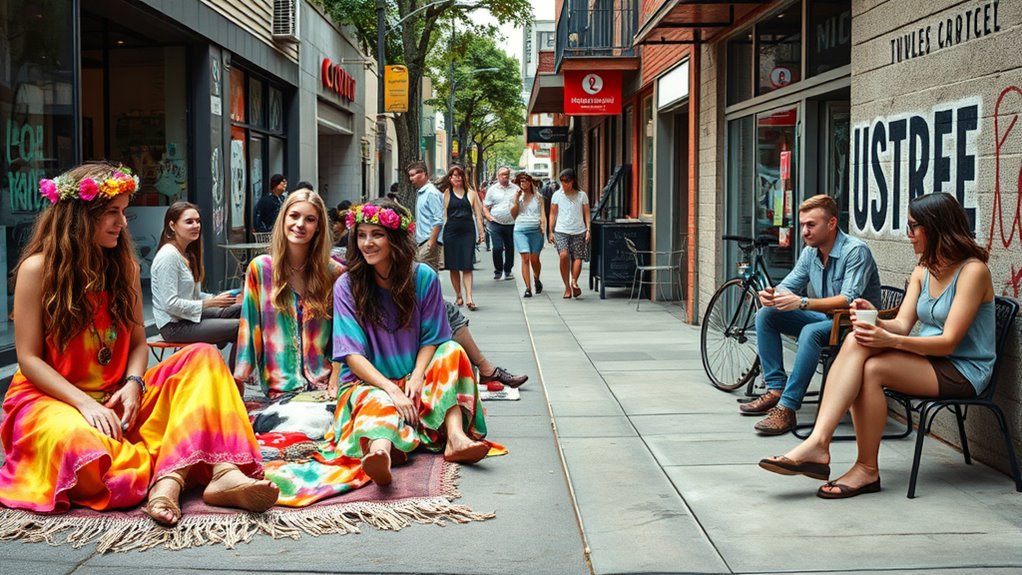
The roots of Bohemia trace back to a region rich in cultural exchange and diverse influences. During medieval times, skilled artists from the area created intricate works that reflected a blend of local traditions and broader European styles. These medieval artists contributed to a vibrant cultural scene, laying the groundwork for the area’s artistic identity. Prior to that, nomadic tribes roamed through Bohemia, bringing with them their customs, beliefs, and craftsmanship. Their transient lifestyle fostered a sense of independence and a willingness to adopt new ideas. Over time, these influences merged, shaping a society that valued creativity, freedom, and resilience. This rich history of artistic innovation and nomadic resilience set the stage for Bohemia’s evolving cultural landscape. Additionally, the region’s early artistic expressions often incorporated iconic designs, which continue to influence modern artistic interpretations of Bohemia’s heritage. Furthermore, the interplay of these diverse influences contributed to the development of a unique cultural identity that persists today. Recognizing the importance of home improvement in preserving cultural heritage, modern efforts often focus on maintaining traditional craftsmanship and architectural styles.
The 1960s Counterculture and the Flower Power Movement
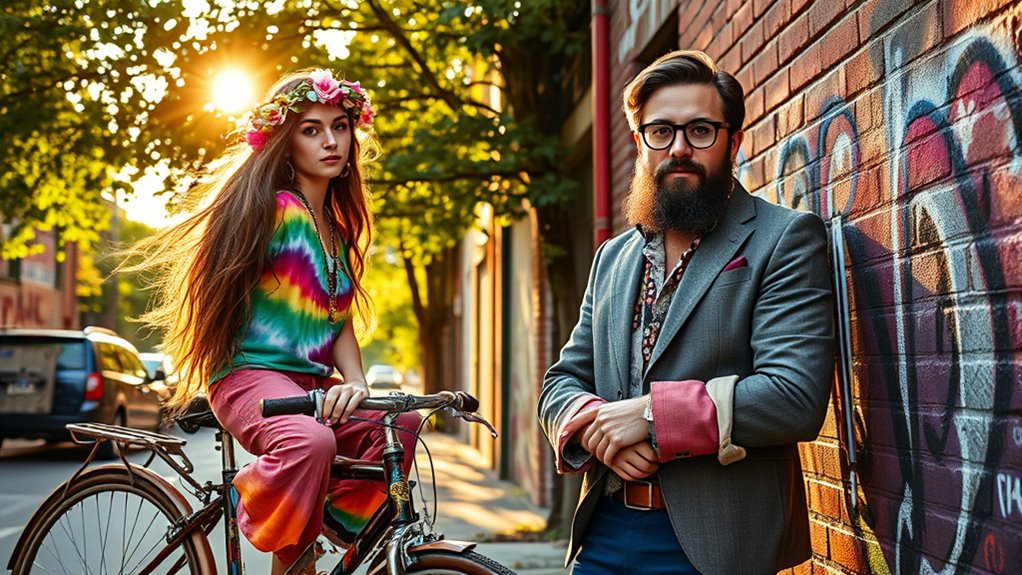
During the 1960s, the counterculture embraced peace and love as guiding principles, shaping attitudes and actions. You’ll notice how iconic fashion statements, like tie-dye and bell-bottoms, became symbols of rebellion and unity. Music, especially with artists like The Beatles and Jimi Hendrix, served as a powerful catalyst that united and energized the movement. Additionally, the influence of the Flower Power movement extended beyond fashion and music, inspiring a broader cultural shift towards individual expression and social activism. This era also saw a growing awareness of investment diversification, encouraging people to explore various ways to secure their financial futures beyond traditional savings. As the movement evolved, it also adopted alternative lifestyles, reflecting a desire for greater personal freedom and authenticity.
Emphasis on Peace and Love
As the 1960s unfolded, a widespread desire for peace and love took hold among young people, fueling a vibrant counterculture movement. You sought spiritual exploration beyond traditional religion, embracing practices like meditation and Eastern philosophies. Communal living became a symbol of unity, where shared resources and collective ideals promoted harmony and compassion. Music festivals like Woodstock became gatherings for expressing love and peace, reinforcing your belief that societal change depended on kindness and understanding. The flower power movement visually embodied this ethos, with vibrant clothing, peace symbols, and an emphasis on nonviolence. You aimed to create a world rooted in love, rejecting war and materialism, and fostering a sense of interconnectedness that defined the era’s bohemian spirit. Recognizing the importance of asset division in the context of societal change, many sought fair ways to distribute shared resources and property in the evolving cultural landscape. Additionally, the movement often incorporated elements of alternative lifestyles, emphasizing personal freedom and nonconformity as central ideals. Moreover, the emphasis on color accuracy and vibrant visual expression reflected the era’s focus on peace and artistic freedom, inspiring cultural and social transformations.
Iconic Fashion Statements
Iconic fashion statements of the 1960s counterculture vividly expressed the movement’s ideals of peace, love, and individuality. You often wore fringe jackets, which added a carefree, bohemian vibe, symbolizing freedom and rebellion. Bright tie-dye patterns became a signature look, representing creativity and unity among the youth. These bold designs, often handmade, showcased your desire to stand out and reject mainstream conformity. Accessories like peace symbols, beads, and flowers further emphasized your connection to the movement’s message of harmony. The fashion was colorful, eclectic, and expressive, reflecting your commitment to peace and personal freedom. Through these statement pieces, you communicated your ideals visually, making your style a powerful form of activism during the era. Fashion choices of the time served as a visual language that conveyed the movement’s core values and aspirations. Additionally, the emphasis on self-expression helped foster a sense of community and shared purpose among young people embracing the bohemian lifestyle. The integration of traditional and natural elements also became a hallmark of the style, celebrating cultural heritage and Indigenous wellness practices that resonated with the era’s appreciation for authenticity and holistic living.
Music as Cultural Catalyst
Have you ever wondered how music became a powerful force that shaped the 1960s counterculture and the Flower Power movement? Music genres like psychedelic rock, folk, and protest songs fueled cultural movements by inspiring activism and unity. Songs became anthems for peace, love, and social change, rallying young people to challenge authority and express their ideals. Concerts like Woodstock turned into symbols of rebellion and community, amplifying the movement’s message. You could feel the energy and passion that music brought to the era, turning it into a catalyst for societal transformation. By blending diverse sounds and messages, music became more than entertainment; it became a powerful tool to promote peace, equality, and cultural evolution. Music’s influence extended beyond entertainment, shaping societal values and inspiring future generations. Understanding the countercultural roots of these musical movements helps explain their lasting impact on societal norms, illustrating how music as cultural catalyst transformed social attitudes and collective identity.
The Rise of the Bohemian Aesthetic in Urban Centers
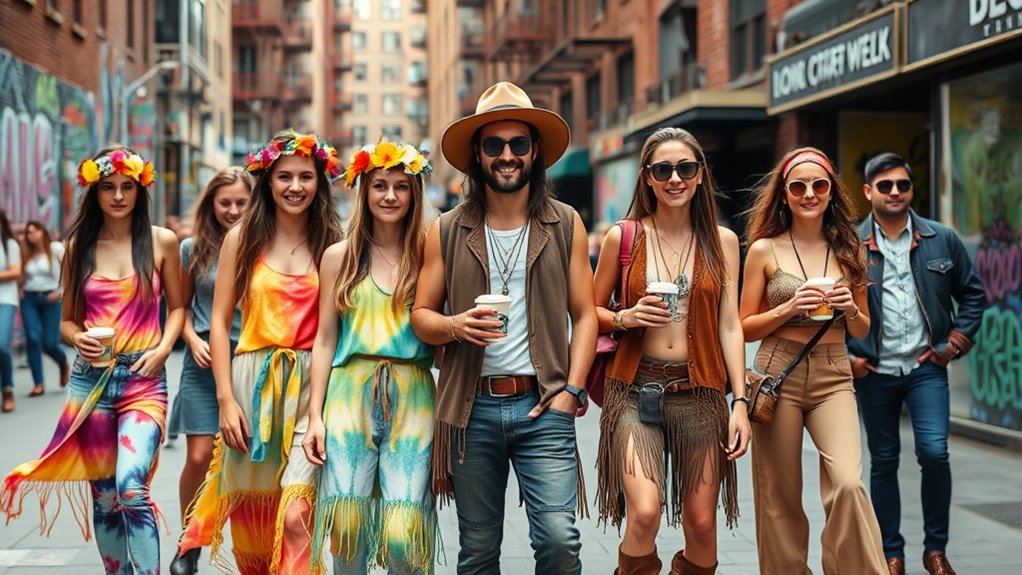
Urban centers have become the vibrant hubs where the bohemian aesthetic flourishes, transforming cityscapes into eclectic showcases of creativity. This movement thrives alongside urban renewal, turning abandoned spaces into artful neighborhoods. Street art, in particular, plays a key role, adding bold colors and rebellious spirit to city walls. You’ll notice how local artists express individuality through murals and graffiti, shaping the bohemian vibe. The following table highlights some elements contributing to this aesthetic:
| Element | Description | Impact |
|---|---|---|
| Urban Renewal | Repurposing old buildings | Revitalizes neighborhoods |
| Street Art | Murals and graffiti | Adds vibrancy and identity |
| Eclectic Decor | Mix of vintage and modern styles | Creates unique urban spaces |
This blend of renewal and street art fuels the dynamic bohemian scene you see today, with urban revitalization playing a crucial role in shaping the expressive environment. Additionally, innovative artistic expressions continue to push the boundaries of urban creativity, fostering a more inclusive and diverse cultural landscape.
Transitioning Into the Modern Era: From Hippies to Hipsters
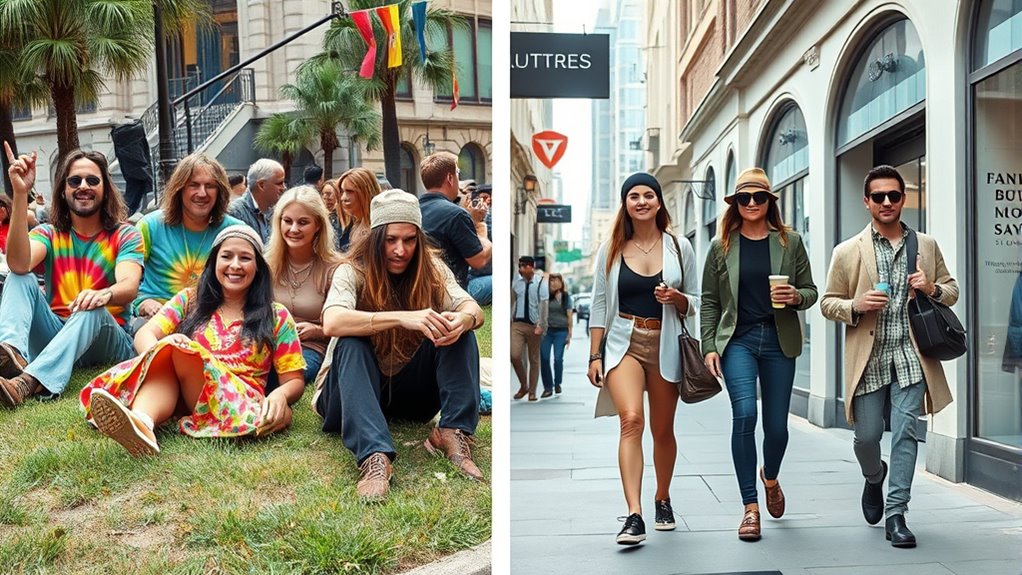
As society evolved from the countercultural movements of the 1960s to today’s fashion-forward neighborhoods, the bohemian lifestyle transformed alongside it. Modern bohemians often embrace a minimalist approach, prioritizing simplicity and intentional living over cluttered displays of eccentricity. You might find yourself drawn to clean lines, versatile pieces, and sustainable choices that reflect this shift. The rise of digital nomads has further reshaped the bohemian identity, blending freedom and flexibility with a focus on experiences rather than possessions. Today’s bohemians travel light, working remotely while immersing themselves in diverse cultures. This evolution shows how the bohemian spirit adapts, balancing creative independence with a streamlined, modern aesthetic suited to the fast-paced, interconnected world. Additionally, some modern bohemians choose names inspired by popular culture to express their unique personalities and tastes. Furthermore, the emphasis on ethical practices in fashion and lifestyle choices highlights the community’s commitment to sustainability and social responsibility. Incorporating innovative gardening solutions, such as unique planters and eco-friendly containers, reflects this shift towards sustainability and thoughtful living.
Contemporary Expressions of Bohemian Spirit in Fashion and Art
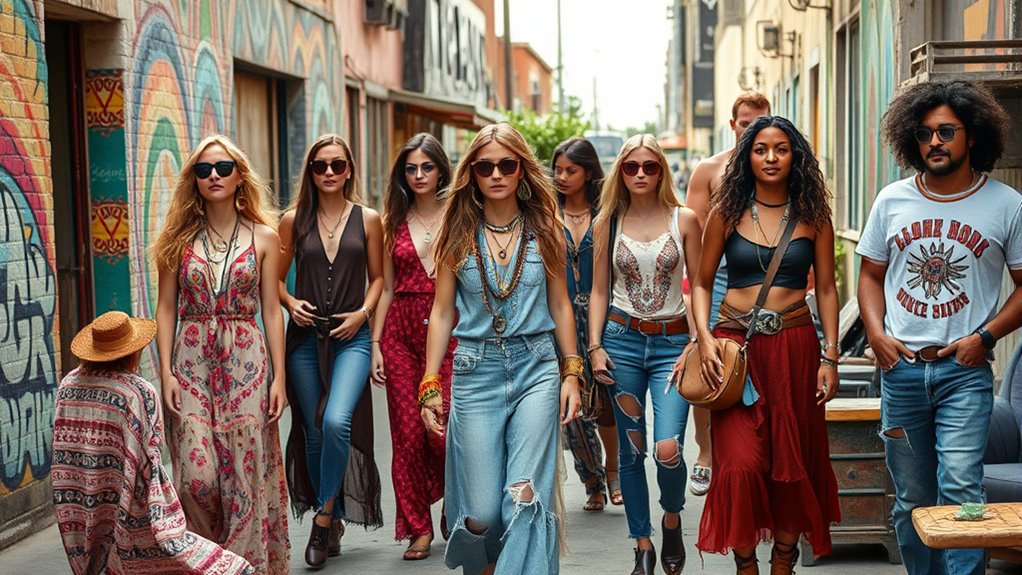
Contemporary bohemian spirit finds vibrant expression in both fashion and art, blending traditional free-spiritedness with modern innovation. In fashion, sustainable craftsmanship takes center stage, with designers emphasizing eco-friendly materials and ethical production methods that honor the original boho values. You’ll notice a mix of vintage-inspired pieces, handcrafted accessories, and flowy textiles that celebrate individuality. Meanwhile, art movements like street art innovations push boundaries, transforming urban landscapes into vibrant galleries. Murals, graffiti, and mixed-media installations embody the rebellious, creative energy of bohemia today. These expressions reflect a desire to break free from conventional norms, embracing authenticity and social consciousness. Together, fashion and art serve as dynamic platforms for the ongoing evolution of the bohemian lifestyle in the contemporary world.
The Enduring Legacy and Future Directions of Bohemian Living
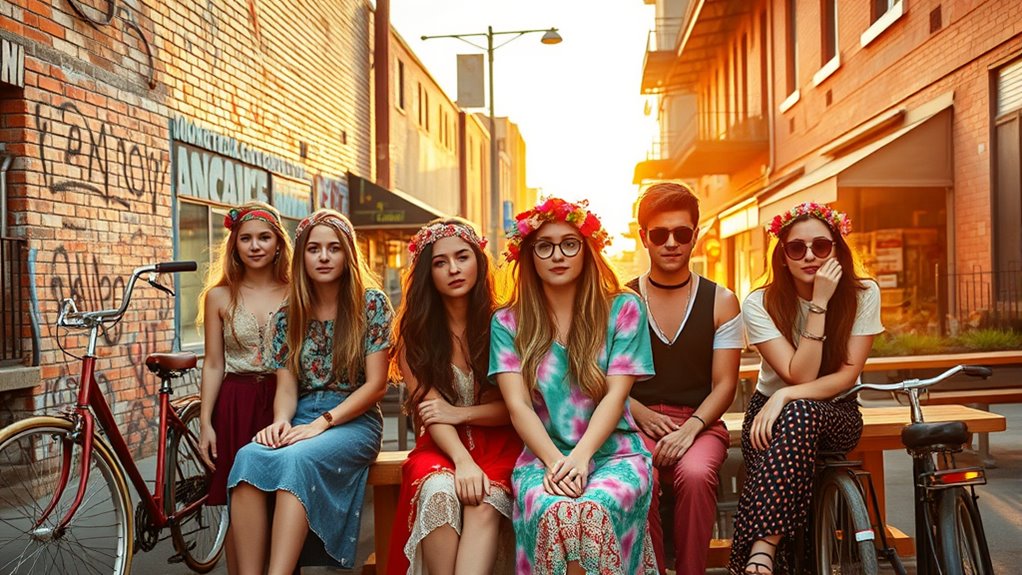
What makes bohemian living endure across generations is its core commitment to authenticity, creativity, and freedom. Today, this lifestyle continues to evolve by embracing modern sustainability, where eco-friendly choices align with artistic expression and personal values. Digital nomadism exemplifies how bohemians seek freedom through mobility, working remotely while exploring new cultures and environments. This shift fosters global communities that prioritize meaningful experiences over material possessions, reinforcing bohemia’s rebellious spirit. Additionally, the emphasis on home organization helps maintain a balanced and inspiring environment for those living a bohemian lifestyle. Incorporating mindset principles from the Law of Attraction can further enhance personal growth and attract positive energies aligned with bohemian ideals. Looking ahead, the future of bohemian living will likely blend eco-consciousness with technological innovation, supporting flexible, creative lifestyles worldwide. You’ll find that the essence remains rooted in individuality and exploration, inspiring new generations to redefine what it means to live authentically and freely.
Frequently Asked Questions
How Did Bohemian Lifestyles Influence Mainstream Fashion Trends?
You can see how bohemian lifestyles shaped mainstream fashion trends through boho chic, blending relaxed, eclectic styles with modern elegance. This fashion influence encourages you to embrace free-spirited, layered clothing, earthy tones, and vintage accessories. As a result, bohemian aesthetics have become a staple in mainstream fashion, inspiring designers and encouraging individuality. Your wardrobe might now reflect these influences, making you feel connected to a history of creative, unconventional self-expression.
What Role Did Technological Advancements Play in Modern Bohemian Culture?
You might think technological advancements just changed how we communicate, but they actually shape bohemian culture too. Digital connectivity lets you access virtual communities that embrace free expression, creativity, and alternative lifestyles. These tools help you share ideas instantly, find like-minded people worldwide, and sustain a modern bohemian identity. Technology fuels this lifestyle by making it easier to connect, collaborate, and explore outside mainstream norms, keeping the bohemian spirit alive today.
Are There Geographic Differences in Bohemian and Hipster Expressions Worldwide?
You’ll notice that bohemian and hipster expressions vary widely across regions due to cultural distinctions and local influences. In cities like Berlin or Brooklyn, you see unique fashion, art, and music scenes that reflect regional tastes. These regional expressions shape how you experience bohemian lifestyles around the world, emphasizing local traditions, histories, and values. So, your bohemian identity can look very different depending on where you are.
How Do Economic Factors Impact the Sustainability of Bohemian Communities?
Like a house of cards, bohemian communities rely heavily on economic resilience. When funding challenges arise, their sustainability gets threatened, forcing members to adapt or disband. Economic factors such as rising living costs and limited financial support make it harder to maintain these vibrant, creative spaces. You might find that without steady resources, the spirit of these communities fades, highlighting the essential need for stable economic foundations to keep their culture alive.
What Are the Environmental Implications of Bohemian-Inspired Lifestyles Today?
You might notice that bohemian-inspired lifestyles today emphasize sustainable practices and eco-conscious consumption. By choosing upcycled furniture, supporting local artisans, and reducing waste, you help lower environmental impact. These lifestyles promote greener habits, like organic gardening and minimalism, which benefit the planet. When you embrace these eco-friendly choices, you contribute to a more sustainable future, aligning your values with environmental preservation and encouraging others to follow suit.
Conclusion
Your journey through bohemia’s evolution shows how its spirit remains a guiding star, illuminating paths of creativity and rebellion. Like a timeless forest, its roots run deep, branching into new forms with each generation. Embrace this ongoing dance of freedom and expression, knowing that the true essence of bohemia is a wandering flame—never extinguished, always inspiring. Keep the fire alive, and let your unique light continue to shape its endless story.


